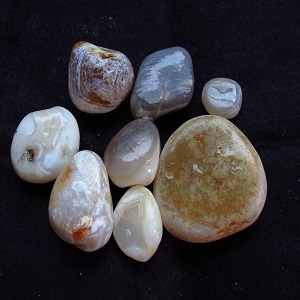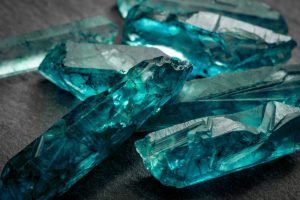
Aquamarine is a blue to blue-green type of beryl gem quality. The beryl group of jewels with green emerald is one of the four precious stones (along with diamonds, sapphires and rubies). Aquamarine is the official birthstone for those born in March.
Aquamarine is hard and has a beautiful vitreous luster similar to glass. This stone has an extraordinary sea blue color that varies from pale blue to medium dark blue. The name “aquamarine” is derived from the old Latin word for “sweet sea”. Aquamarine and green emerald are from the same family, but they are surprisingly different. Aquamarine and green emerald are both beryllium aluminum silicates, but green emerald is found with trace amounts of chromium (and sometimes vanadium), while aquamarine gets its color from iron impurities in colorless beryl (goesnite). Aquamarine and green emerald have the same gravity and refractive index, but green emerald tends to be opaque and full of opacity, and on the contrary, aquamarine offers good clarity and clarity. Aquamarine stone is one of the blue emerald stones and belongs to the family It is considered beryl stones and its name is derived from a Latin word meaning sea water, which refers to the color of this stone, which is very similar to the blue color of the ocean and the sea. Aquamarine stone is one of the clear and transparent stones and It is seen in blue and bluish-green colors.
The color of this stone is due to the iron oxides in its chemical composition.
Aquamarine detection
Aquamarine and other types of beryl stones with a hardness of 7.5 to 8 on the Moose scale are quite durable and hard. Dark and deeply saturated blue is considered a desirable and valuable color in aquamarine. Other types of beryl are morganite, goshenite, golden beryl (heliodor), green beryl and bixbit.
Aquamarine is often recognized by its unique sea blue color. This stone is very hard and has a glass luster. Aquamarine stones have better transparency than other similar gems.
The color intensity and clarity of the stone are the most important criteria for evaluating aquamarine, and then the quality of the cut is the next step. Aquamarine is colored with a small amount of iron, and in the tests of compounds, the amounts of elements and the hexagonal crystal structure easily distinguish it from other blue-green stones.
Sources and origin of aquamarine
With many mines throughout the country, Brazil can be considered the main producer of aquamarine. Other aquamarine deposits are located in Australia, Myanmar (Burma), China, India, Kenya, Madagascar, Mozambique, Namibia, Nigeria, Pakistan, Zambia, and Zimbabwe, as well as in several locations in the United States. Aquamarine stoners have become.
Aquamarine known in the world
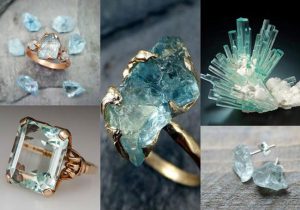
The largest discovery of gem-quality aquamarine occurred in 1910, when the Minas Gerais mine in Marambara, Brazil, found a stone weighing 243 pounds (110.5 kg), 18 inches (48.5 cm) long, and 15.5 inches in diameter, which A highly cut gem with a total weight of over 100,000 carats was unearthed.
Weighing 26 kilograms, Dom Pedro was cut by German jewelry designer Bernd Munsteiner in 1992 in Idar Eberstein, Germany, and is the largest piece of aquamarine ever discovered.
Buying and valuing aquamarine gemstones
Aquamarine color
Aquamarine, like seawater, comes in light blue, dark blue, blue-green, and blue-green colors. The more saturated the color, the higher the value, although almost all blue emeralds usually have a lighter blue in them. Deeply saturated blue is the most desirable color, but is rarely found in large specimens.
Color intensity is one of the most important criteria in evaluating colored gemstones, but unlike other gemstones, aquamarines with lower color intensity will not be worth less because most emeralds are pastel blues and many people prefer lighter gemstones with clear crystals. They prefer stones with deep and bold colors.
The brilliance and clarity of aquamarine
Some jewels have long bezels and hollow shafts, and a sign of the beryl family. The parallel marks of foreign minerals, which is considered one of the rare features, creates the phenomenon of a cat’s eye (shiny and polished) or a star (stellar) with six clear rays.
These species are available in cut form. High quality cat’s eye aquamarines have very high prices. Six-ray species with a star or “stellar aquamarine” are extremely rare and very valuable. Aquamarine has a vitreous luster after cutting.
Aquamarine cut and shape
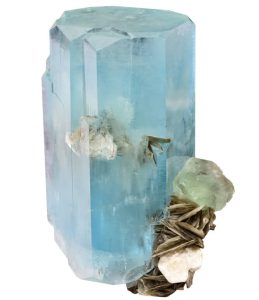
Aquamarine is found in two cuts, cut and cut. Brills are especially suitable for rectangular or square cuts. The most popular aquamarine cut is the emerald green step cut. Diamond cuts with long or rectangular shapes are also very popular.
Polished and messy cheeks are the same as cat-eye and star-shaped cheeks. Skilled jewelers are able to carve any possible shape with aquamarine. The most common types of cuts are traditional shapes such as round, pear, oval.
Fancy cuts are hard to find in larger sizes. Sometimes aquamarine and other types of beryl are cut into decorative shapes and animal carvings.
Aquamarine processing
Aquamarine often does not require special processing, but sometimes heat is used to process the color. Heating at a low temperature will reduce unwanted green and yellow colors. Darker colors of aquamarine, like lower quality stones, are often heated (usually at 725-850 F or 400-450 C
grad) to create a more suitable blue color. Heating at a higher temperature causes discoloration.
Aquamarine-like species
Aquamarine belongs to the beryl group of minerals. There are a few varieties of gem-quality beryl, most of which are classified by color and color factors, such as emerald green. Aquamarine is also found with polish (cat’s eye and star aquamarine) which are very rare and valuable. Other gemstones that are similar to aquamarine are Larimar, Amazonite, Tourmaline, Sapphire and Lal Badakhshan.
The most famous gemstones and related brand names
Green emerald, precious beryl, golden beryl, cat’s eye aquamarine, and morganite are some of the most famous related gemstones. Lesser known gemstones and brand names are red beryl or bixiebit, heliodor, green beryl, and goshenite. colorless beryl) are among the lesser known gemstones.
Aquamarine Gemstone and Jewelry Design Ideas
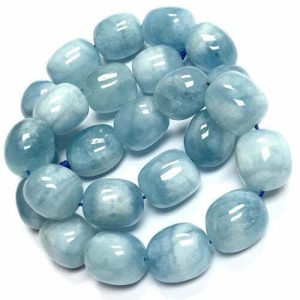
Aquamarine is a decorative gem that suits almost any skin tone or eye color, making it a favorite among women all over the world. Aquamarine is a well-known gem that is easy to wear, readily available, reasonably priced, and constantly growing in popularity. Aquamarine has a consistent hardness that makes it suitable for any type of jewelry application, including the design of aquamarine rings. Green emerald, from the aquamarine stone family, is usually oiled to fill cracks and restore color, but aquamarine does not require special maintenance and is suitable for all types of jewelry, including regular rings.
Aquamarine stone is very popular in earrings. Additionally, whole, clear, and hexagonal crystals are sometimes used uncut as necklaces. In addition to rings, pendants and earrings, aquamarine stones are set on bracelets, necklaces, brooches, etc.
Note: Gemstones should be purchased by size, not carat weight. Colored stones vary in size and weight. Some stones are larger and others smaller than diamonds by weight.
Maintenance and washing of gemstones and aquamarine jewelry
Aquamarine is one of the most durable gemstones, but still requires careful maintenance and care. Avoid wearing aquamarine jewelry when working with strong chemicals. To prevent scratches, always store aquamarine gemstones separately from other types of gemstone jewelry.
When cleaning, use warm soapy water and a towel or soft cloth for drying. Wash the stone well and remove all soap residue. To store them for a long time, put the stones in a soft cloth or a soft cloth box.

